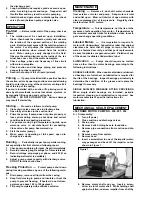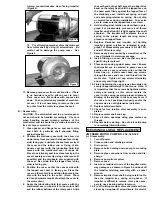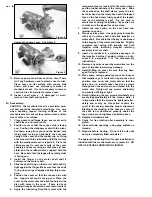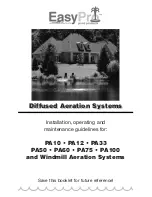
MOTORPUMP
™
z
INSTALLATION
z
OPERATION
z
MAINTENANCE
INCLUDES MECHANICAL
SEAL
REPLACEMENT
Check pump for shortage and damage immediately upon
arrival. Note damage or shortage on freight bill (bill of
lading); immediately file claim with carrier.
EXTERIOR
— Pay particular attention to conduit box,
external hardware and accessories. Touch up abrasions
or scratches with approved paint.
INTERNAL
— If extensive or serious external damage
is noted, if impeller is damaged (look in ports), or if shaft
binds or sticks, disassemble as required to permit
internal inspection.
Handle with care. Dropping or jarring can seriously dam-
age motor bearings or break pump parts. Lift with device
having capacity for pump weight, and use lifting hooks or
eye bolts (if provided) or rig double sling around motor
frame and pump casing. Do not use sling through pump
motor adapter nor around suction and discharge flanges.
Location —
Pump location should provide the following:
1.
Install as close to suction supply as possible.
2.
Shortest and most direct suction pipe practical.
Suction lift must not exceed limit for pump. NPSH
available must equal or exceed pump requirement.
3.
Suction port below pumping level to provide priming.
4. Use caution when mounting pumps with mounting
base affixed to case. When the motor base and
mounting feet of the case are not on the same plane,
install a riser or shim under the motor mounting feet.
Ensure the pump case feet are flush with the moun-
gin platform, Do not over-tighten to pull case down
to meet platform.
5.
Room for inspection and maintenance.
6.
Correct power supply to motor; all wiring should
meet National Electrical and Local Codes and
Regulations.
7.
If outdoors, protection from the elements, freezing
and water damage due to flooding.
Piping —
Suction and discharge gauges are useful to
check pump operation and are excellent trouble indica-
tors. Install gauges in the lines if pump ports do not have
gauge taps. Observe these precautions when installing
piping:
1.
Support close to, but independently of pump.
2.
Use the next larger pump size for suction and dis-
charge.
3.
Keep as straight as possible. Avoid bends and fit-
tings.
4.
Remove burrs, sharp edges, ream pipe cuts, and
make joints air-tight.
5.
Don’t spring pipe to make connections. Strain must
not be transmitted to pump.
6.
Allow for pipe expansion with hot fluids; expansion
joints are not recommended.
Suction
— Size and install suction piping to keep pres-
sure loss at minimum and to provide correct NPSH by
observing the following:
1.
The suction pipe should be equal in size or preferably
one size larger than the suction connection of the
pump. If pipe is larger than the pump suction, an
eccentric pipe reducer should be used at the pump.
2.
Pipe should slope upward to pump, even for horizon-
tal run.
3.
Use 45-degree or long-sweep 90-degree elbows.
4.
A valve in the suction is necessary only on positive
suction head installation and must not be used to
throttle the pump. The suction valve should be
installed for maintenance purposes only.
Discharge —
Pumps permit discharge port location at
two positions, 30 degrees apart. Change by removing
cover bolts, rotate casing, and replace bolts. Do not slice
O-ring. Scot does not recommend bottom vertical, 3:00
or 9:00 discharge positions due to erratic pump perfor-
mance. Ensure there is adequate clearance with selected
position between wall or tank, motor conduit box, and
grease fittings. Casing may extend beyond base or feet.
1
Short discharge lines may be the same size as the
discharge port. Long runs require a pipe larger than
INSTALLATION
HANDLING
61.000.281
DECEMBER 2017
• Cedarburg, WI 53012
• P.O. Box 286
• 262-377-7000
• FAX 262-377-7330
Scot Pump A Wilo Company — Main Office and Manufacturing Facility
J56 & JM FRAME
304 STAINLESS STEEL
PUMP NO. 230-232, 236, 320-328
Replaces Nov 2009






















